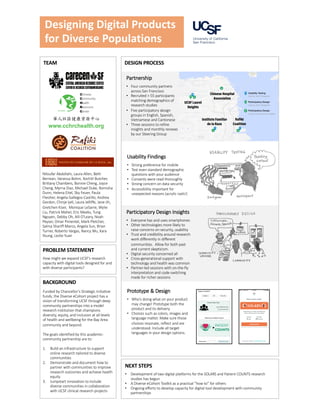Designing Digital Products for Diverse Populations
- 1. Funded by ChancellorŌĆÖs Strategic Initiative funds, the Diverse eCohort project has a vision of transforming UCSF through deep community partnerships into a model research institution that champions diversity, equity, and inclusion at all levels of health and wellbeing for the Bay Area community and beyond. The goals identified by this academic- community partnership are to: 1. Build an infrastructure to support online research tailored to diverse communities 2. Demonstrate and document how to partner with communities to improve research outcomes and achieve health equity 3. Jumpstart innovation to include diverse communities in collaboration with UCSF clinical research projects Designing Digital Products for Diverse Populations TEAM BACKGROUND PROBLEM STATEMENT How might we expand UCSFŌĆÖs research capacity with digital tools designed for and with diverse participants? NEXT STEPS ŌĆó Development of two digital platforms for the SOLARS and Patient COUNTS research studies has begun ŌĆó A Diverse eCohort Toolkit as a practical ŌĆØhow toŌĆØ for others ŌĆó Ongoing efforts to develop capacity for digital tool development with community partnerships DESIGN PROCESS Usability Findings ŌĆó Strong preference for mobile ŌĆó Test even standard demographic questions with your audience ŌĆó Consents were read thoroughly ŌĆó Strong concern on data security ŌĆó Accessibility important for unexpected reasons (acrylic nails!) Partnership ŌĆó Four community partners across San Francisco ŌĆó Recruited > 55 participants matching demographics of research studies ŌĆó Five participatory design groups in English, Spanish, Vietnamese and Cantonese ŌĆó Three sessions to refine insights and monthly reviews by our Steering Group Niloufar Abdollahi, Laura Allen, Beth Berrean, Vanessa Bohm, Xochitl Butcher, Brittany Chambers, Bonnie Cheng, Joyce Cheng, Myrna Diaz, Michael Duke, Romisha Dunn, Helena Eitel, Sky Feuer, Paula Fleisher, Angela Gallegos-Castillo, Andrea Gordon, Chinje Ijeli, Laura Jelliffe, Jane Jih, Gretchen Kiser, Monique LeSarre, Wylie Liu, Patrick Maher, Eric Meeks, Tung Nguyen, Debby Oh, Alli O'Leary, Noah Peyser, Omar Pimentel, Mark Pletcher, Salma Shariff-Marco, Angela Sun, Brian Turner, Roberto Vargas, Nancy Wu, Kara Young, Leslie Yuan Prototype & Design ŌĆó WhoŌĆÖs doing what on your product may change! Prototype both the product and its delivery. ŌĆó Choices such as colors, images and language matter. Make sure those choices resonate, reflect and are understood. Include all target languages in your design options. Participatory Design Insights ŌĆó Everyone has and uses smartphones ŌĆó Other technologies more likely to raise concerns on security, usability ŌĆó Trust and credibility around research work differently in different communities. Allow for both past and current skepticism. ŌĆó Digital security concerned all ŌĆó Cross-generational support with technology and health was common ŌĆó Partner-led sessions with on-the-fly interpretation and code-switching made for richer sessions
